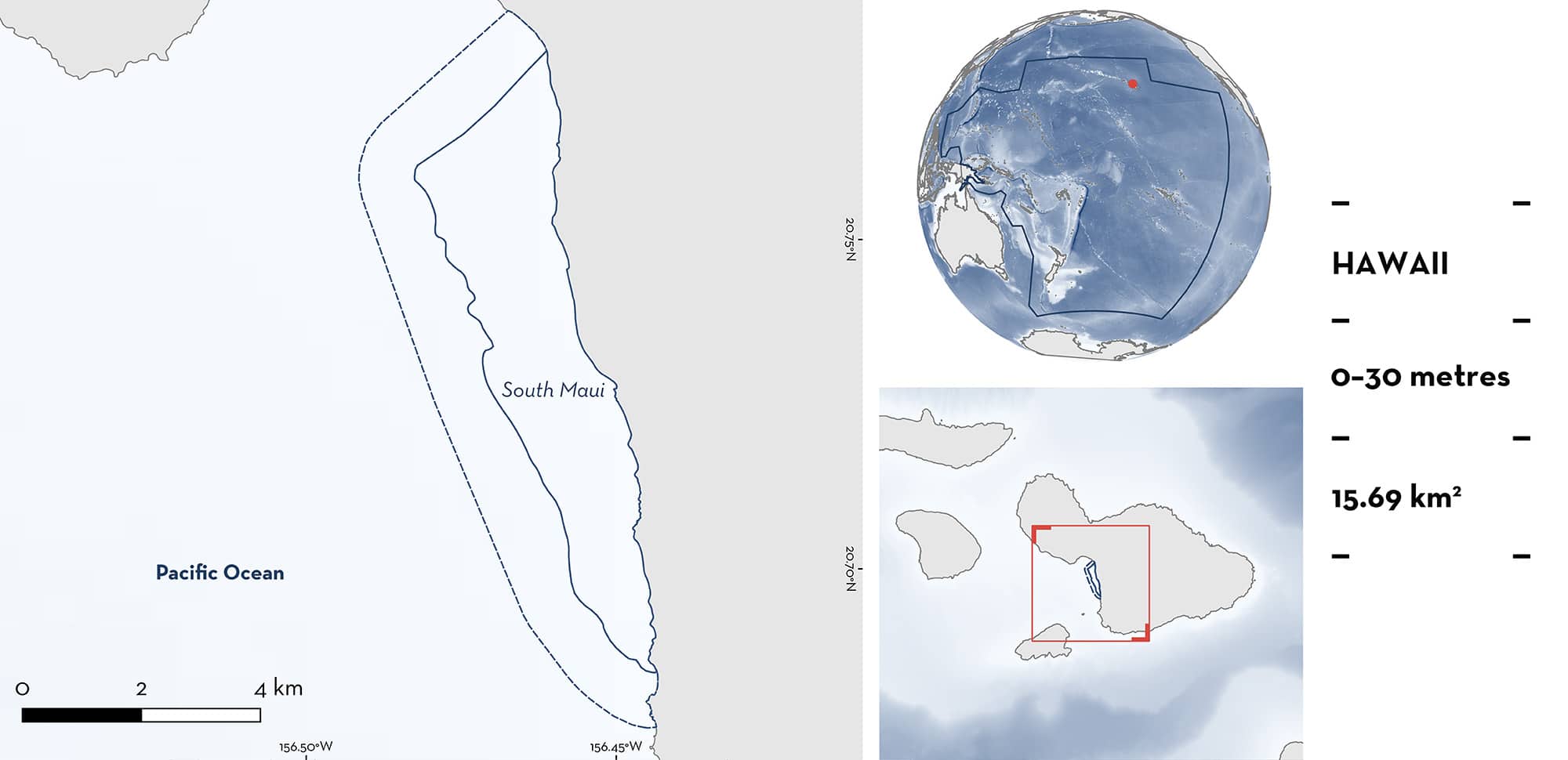ISRA FACTSHEETS
ISRA FACTSHEETS
NEW ZEALAND & PACIFIC ISLANDS REGION
South Maui
Summary
South Maui is located in the Hawaiian Islands of the United States of America. The area is situated on the western coastline of Maui and overlaps the Kīhei reef tract and is characterised by relatively high levels of coral cover and complex topography. Within this area there are: threatened species and reproductive areas (Reef Manta Ray Mobula alfredi).
Download factsheet
South Maui
DESCRIPTION OF HABITAT
South Maui is located in the Hawaiian Islands of the United States of America. The area is situated along the western coastline of Maui. Within the area is the Kīhei reef tract: a linear reef extending from Māʻalaea Bay on the north to Wailea in the south (Field et al. 2019). Bands of relatively high coral coverage are found close to shore off central and north Kīhei and are not continuous into deeper water. In deeper water in Māʻalaea Bay and off south Kīhei, there are large areas of high coral cover on complex topography (Golden et al 2015). Māʻalaea Bay is largely a carbonate sediment-filled embayment with well-developed coral ridges in the outer part of the southern half of the bay.
This Important Shark and Ray Area is benthic and pelagic and is delineated from inshore and surface waters (0 m) to 30 m based on the bathymetry of the area.
CRITERION A
VULNERABILITY
One Qualifying Species considered threatened with extinction according to the IUCN Red List of Threatened Species regularly occurs in the area. This is the Vulnerable Reef Manta Ray (Marshall et al. 2022).
CRITERION C
SUB-CRITERION C1 – REPRODUCTIVE AREAS
South Maui is an important reproductive area for one ray species.
Between 2006–2023, scientific surveys recorded 226 sightings of Reef Manta Rays in the area, comprising 117 individuals identified using photographic identification (MH Deakos unpubl. data 2024). Of these, 17 individuals were measured using paired laser photogrammetry between 2015–2018, with an average disc width (DW) of 230 cm (MH Deakos unpubl. data 2024). Most (58.8%, n = 10) measured individuals were neonates/young-of-the-year (YOY), measuring 196–229 cm DW (mean = 212 cm DW). The reported size-at-birth for this species in the wild is 130–150 cm DW (Marshall et al. 2022), and a Reef Manta Ray born at 182 cm DW in aquaria measured 261 cm DW at 10 months-old (Nozu et al. 2017; Murakumo et al. 2020). Considering the size-at-birth and this rapid initial growth, we considered all individuals =<230 cm DW to be YOY. This area has global importance given the rarity in the regular and predictable presence of early life stage Reef Manta Rays at most aggregation sites (Setyawan et al. 2022). Feeding behaviour has been recorded in the area, potentially an indicator of this being an important foraging habitat for these young animals, however, more information is needed to confirm this. Six of the size measured Reef Manta Rays were tagged with GPS satellite trackers (duration 4–19 days) and revealed site fidelity to South Maui by these young rays (MH Deakos unpubl. data 2024), supporting the importance of the area to early life stages for this species.
Download factsheet
SUBMIT A REQUEST
ISRA SPATIAL LAYER REQUEST
To make a request to download the ISRA Layer in either a GIS compatible Shapefile (.shp) or Google Earth compatible Keyhole Markup Language Zipped file (.kmz) please complete the following form. We will review your request and send the download details to you. We will endeavor to send you the requested files as soon as we can. However, please note that this is not an automated process, and before requests are responded to, they undergo internal review and authorization. As such, requests normally take 5–10 working days to process.
Should you have questions about the data or process, please do not hesitate to contact us.


